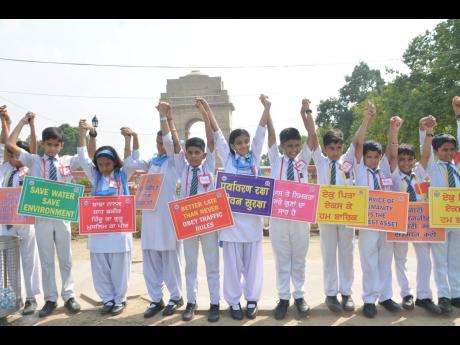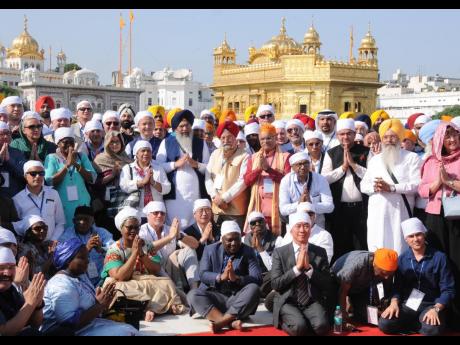Saint of the masses - Celebrating the life of Guru Nanak – founder of the Sikh faith
It is rare to come across prophets who are equally revered by the people of different religions, social milieu, and ethnicities. Guru Nanak, the founder of Sikhism, is one of them. He was born in 1469 in the erstwhile Punjab province of India.
From his childhood, he rebelled against the existing religious dogmas and social practices based on blind faith or mere superstition. He showed no interest in the mundane ritualistic life and, instead, advocated unconditional devotion to the true Lord Supreme, Sat Kartar.
He had an inquisitive mind, which often led him into trouble with his teachers, who failed to quench the thirst of his curiosities. From his early life, he was an embodiment of compassion. When his father gave him money to start a business, he spent the entire amount feeding the deprived. On being questioned about his business, he replied that by feeding the hungry, he had performed the “true deal”, or a “Sacha Sauda”. For him, in the realm of God, there could be no deal better than helping the needy.
Guru Nanak was born at a time when there was widespread anarchy and strife in the society. The caste system that had divided the society into four segments – Brahmins (the priests), Kshatriya (the warriors), Vaishya (the traders), and Shudras (labourers) – had caused the unimaginable amount of injustice and friction in the society.
The priestly class had become corrupt, the warriors were involved in fierce battles for supremacy, the trading class started the economic exploitation of the unprivileged class, and the Shudras, being considered subservient to all three, had to bear the brunt and face the abhorrent act of ‘untouchability’ practised by the three ‘higher’ classes against them.
Guru Nanak, although born into a ‘high-class’ family of the social hierarchy of that time, was an insignia of humility. He always stood by and described himself to be among the ‘lowest of the low’(“ Neecha Andar Neech Jaat Neechi Hu At Neech, Nanak Tin Ke Sang Saath Vadian So Kya Rees” – Guru Granth Sahib (the holy scripture of Sikh faith).
Practised what he preached
Guru Nanak practised what he preached and preached what he practised. He aspired to create an egalitarian society in which there was justice and fair play for all. Therefore, while selecting his successor, the second guru of the Sikh faith, overlooking his own two sons, presumably the natural heirs, he nominated an outsider, Bhai Lehna ji.
In the old social fabric, women were discriminated against and considered inferior to men. Guru Nanak relentlessly tried to correct this imbalance inequality questioning “So Kyon Manda Akhiye Jis Jamme Rajan” (Guru Granth Sahib), ‘meaning’, why look down upon the women who give birth to great kings and warriors?’ He also firmly stood against the horrible custom of Sati Pratha, the practise in which women were required to commit suicide by self-immolation upon the death of their husbands. This was one of the cruellest and most heinous social practices prevalent at that time. Nanak raised his voice against this social evil to ensure a peaceful and respectful life for the widows in the society.
The fundamental tenets of Guru Nanak’s teachings are Kirat Karo (earn through fair means), Naam Japo (be in the remembrance of the god), and Vand Chhako (share with the needy). Through Kirat Karo, he taught to lead a life with honest and hard work, saying Ghal Khaye Kuchh Hathon De Nanak Rah Pachhane Se, meaning that those who will earn their livelihood honestly are the ones who find the correct path. By Naam Japo, he advocated for remembrance of God by counting His blessings and remaining ever thankful to Him.
To inculcate the spirit of Vand Chhako and to put an end to the menace of social and economic inequalities, he introduced the concept of Langar (community kitchen), where people from all walks of life sit down shoulder to shoulder and eat without any separation of the high or the low. The custom of Langar has since been institutionalised, and in the gurudwaras (abode of the gurus or Sikh temples) around the world, one can go and have a free meal. Through this, he pioneered the concept of Rana Runq Brabari, i.e., equality between the kings and the poor.
In spreading his message of universal brotherhood, compassion, equality of human beings, and opposition to fanaticism and hollow superstitions, Guru Nanak undertook long travels to different parts of the world from 1500-1524, navigating about 3,000kms in all four directions. All these travels were undertaken mostly on foot, accompanied by his companion, Bhai Mardana.
He travelled to all the important social and religious centres of Hindus, Muslims, and Buddhists, – Haridwar, Prayag, and Ayodhya (Hindu holy cities in India); Tibet and China in the north up to Assam (eastern Indian state) and Myanmar in the East; Mecca and Madina; Syria, Iraq and Iran in the west; and Sangaldip (Sri Lanka) in the south.
Spiritual hymns
He penned many spiritual hymns, Gurbani (word of the guru), during these long journeys that have been incorporated into the principal holy scripture of the Sikhs – Guru Granth Sahib – which has been bestowed the status of the last and final guru and the fountainhead of all spiritual guidance.
Today, Sikhism is the fifth largest religion in the world. With a following of about 30 million worldwide and 90 per cent of them living in India, they are spread all over the world. There are about 500,000 Sikhs in Canada, an equal number in the United Kingdom, and about 250,000 in the United States. The other countries with sizeable Sikh populations are United Kingdom, Australia, Malaysia, Thailand, and Italy.
Although Sikhs form just about 1.7 per cent of India’s population and are a religious minority, thanks to their hard work, sincerity, entrepreneurial skills, valour, and dedication and devotion to the country, they have excelled in all spheres of national life there India and have acquired high positions – a former president, prime minister, chief justice, and chief of army staff.
As a befitting tribute to their contribution, the government of India has taken several decisions to commemorate the 550th birth anniversary of Guru Nanak Dev ji, which include the construction of a special corridor to the Pakistan border for visit of Sikh pilgrims to Kartarpur Sahib (Pakistan), the final resting place of Guru Nanak Dev JI. Sultanpur Lodhi, a town that is historically connected with Guru Nanak JI, will be developed as a heritage city.
Indian missions/posts abroad are also actively celebrating these events in association with local communities.
In Jamaica, several congregations are being organised by the Sindhi Hindu community in Kingston, Ocho Rios, and Montego Bay to mark the occasion and to rededicate themselves to Guru Nanak Dev JI’s concept of Sarbat da Bhala (well-being of the entire humanity). This planet can be a better place to live if we follow his teachings.
- Girish Kumar Juneja is charge d’ affaires at the High Commission of India in Jamaica, Kingston. This article is a tribute to the founder of the Sikh faith, Guru Nanak Dev, whose 550th birth anniversary is on November 12.




